|
Thread Number: 25811
Miele Power Splitter Box For Sale - $150 |
[Down to Last] |

|
| Post# 396477 , Reply# 1 11/29/2009 at 20:09 (5,253 days old) by bosch2460 (Harrisonburg, VA) | ||
Hmmmm
I have one of those boxes, too. I got mine off of Ebay for the same price you are asking. I have a Miele 1966 plugged into one side, and a 1979 G.E. dryer in the other. Yes, I am aware that its for Miele only, but I had to make do with what I had. And yes, I can run them both at the same time. My American dryer will NOT run on regular heat plugged into that box, regardless. If I do run it on any higher setting, it throws it's own switch and cuts power. It will, however, run on low, and timed dry only. So, I extract everything that needs to be put in the dryer in the Miele at 1200 rpm. A big load of towels or jeans dries in about 50 min, 1 hour max. Knowing full well that the dryer is technically not to be shared with the 220V Miele, I never leave the house with the dryer on...in the event that I even use the dryer. I am a line drier 90 percent of the time. Ya'll let me know if I am destined to have my house burned down. I just wanted to chime in, and let you all know that you can change an American plug to match a Euro plug and use one of these with an American dryer if u want to. :) Joel | ||
| Post# 397833 , Reply# 3 12/6/2009 at 11:10 (5,247 days old) by mrx () | ||
|
French and Belgian Version : The ground contact on the French and Belgian version is the pin at the top, rather than the clips on the normal version. The same plug fits both. 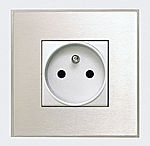
| ||
| Post# 397835 , Reply# 5 12/6/2009 at 11:14 (5,247 days old) by mrx () | ||
|
Non-grounded small appliance plug This is what you'll find on small appliances in Europe (except UK, Ireland, Malta and Cyprus) that are rated less than 2.5amps i.e. most small things. Fits all socket outlets, except the UK, Ireland, Malta and Cyprus system. 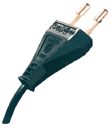
| ||
| Post# 397836 , Reply# 6 12/6/2009 at 11:16 (5,247 days old) by mrx () | ||
|
Grounded European plug Here's the 16A grounded version : (CEE 7/7) 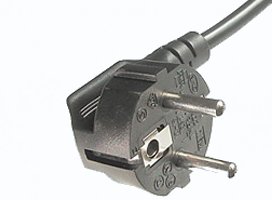
| ||
| Post# 397837 , Reply# 7 12/6/2009 at 11:18 (5,247 days old) by mrx () | ||
|
Non-grounded European plug - 16amps Here's the non-grounded 16amp plug 'Contour plug' You'll find this on anything that draws more than 2.5amps but doesn't need a ground. Except in the UK, Ireland, Malta, Cyprus etc. Hope that explains the Euro system(s) :D 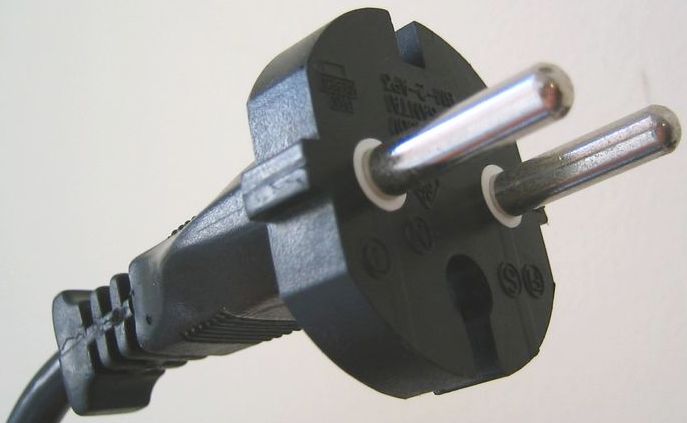
| ||
| Post# 397864 , Reply# 9 12/6/2009 at 15:33 (5,247 days old) by mrx () | ||
|
There's also a Swiss and a Danish system. The Danish system's being phased out in favour of the French style sockets above. The Danish system's very cute though :D Smiley faces! Here's a tripple socket! 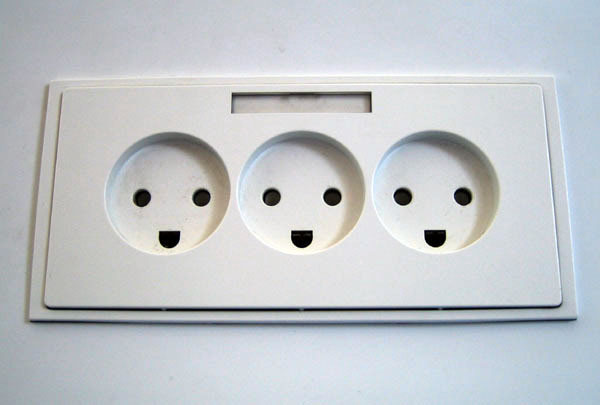
| ||
| Post# 398315 , Reply# 11 12/8/2009 at 18:10 (5,245 days old) by pmclean () | ||
|
Miele Power Splitter Box So can anyone tell me anymore about this box, eg who could use it ? | ||
| Post# 398713 , Reply# 15 12/10/2009 at 06:28 (5,243 days old) by toggleswitch2 () | ||
|
~From what I gather, the French system is being adopted by Denmark, rather than German-style Schuko because it's fully polarised / polarizable. Makes total sense. Thank you, I had not thought of that. | ||
| Post# 398756 , Reply# 17 12/10/2009 at 11:55 (5,243 days old) by nmassman44 (Brooksville Florida) | ||

One thing with that box its made for a 240 volt Miele washer and 240volt dryer. Most if not all Miele washers sold today in North America except for the Little Giants are 120 volt. When I bought my Miele w4800 washer and T9800 dryer the washer was 120v and the dryer had a 4 prong plug attached. I needed to buy an adapter cord to convert it from 4 prong down to 3 since I had a 3 prong 240 volt outlet for the dryer. That cord cost me about $80. That box I saw at the dealer and they had it listed for $150. The other end of that plug is 3 prong thats why Miele says to have the box grounded.
| ||
| Post# 398761 , Reply# 18 12/10/2009 at 12:36 (5,243 days old) by toggleswitch2 () | ||
|
Persoanlly, I'd love a 220v boil-washer and a condenser dryer IN ADDITTION to my regular machines. And by that I mean a top-loader and a gas, vented dryer. | ||
| Post# 398918 , Reply# 22 12/11/2009 at 04:58 (5,242 days old) by mrx () | ||
|
Sorry that should have read 1900's not 19th century !! Woops! :) | ||

 Comes to the Rescue!
Comes to the Rescue!